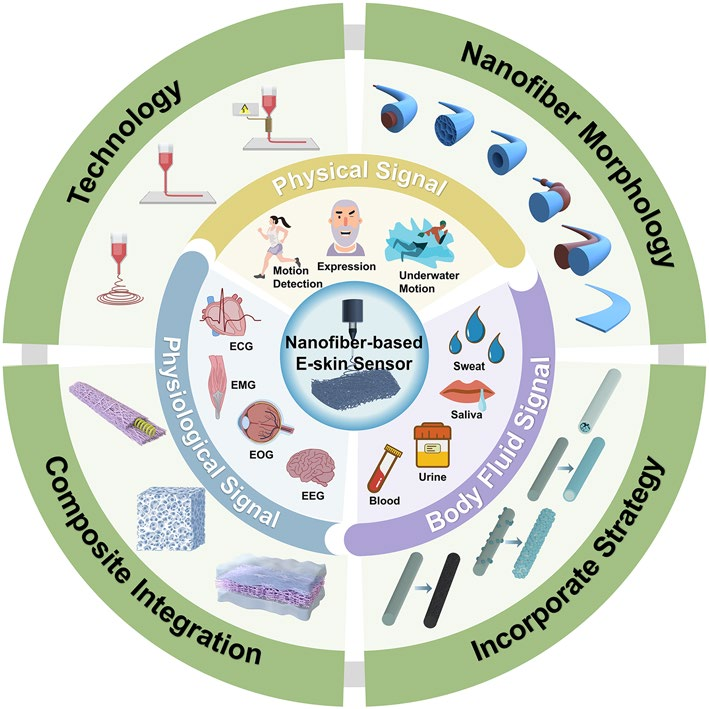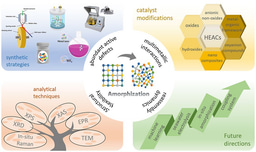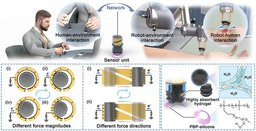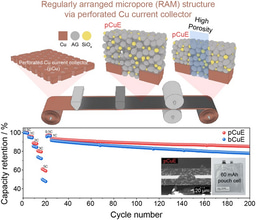Recent Progress of Electrospun Nanofiber-Based Composite Materials for Monitoring Physical, Physiological, and Body Fluid Signals
Published in Materials

A research team led by Si Cheng from Soochow University and collaborators have provided a comprehensive review of electrospun nanofiber-based composite materials for wearable electronic skin (E-skin) applications. Published in Nano-Micro Letters, the study highlights how electrospinning technology and composite design strategies are shaping next-generation flexible sensors for monitoring human physical, physiological, and body fluid signals.
Why Electrospun Nanofibers Matter
Electrospun nanofibers combine high surface area, tunable porosity, mechanical flexibility, and breathability, making them ideal scaffolds for wearable sensors. By integrating these one-dimensional fibers with functional materials such as hydrogels, aerogels, and metals, researchers have achieved composites with enhanced electrical, mechanical, and sensing performance. These hybrid structures mimic skin-like properties while enabling efficient signal transduction for human–machine interaction and health monitoring.
Design Strategies and Composite Architectures
The review outlines electrospinning methods—including far-field, near-field, and melt electrospinning—alongside diverse fiber morphologies such as core–shell, porous, hollow, and Janus structures. Functionalization approaches (mixing, coating, in situ growth/polymerization, and carbonization) further expand nanofiber versatility. Three main composite systems are emphasized:
- Nanofiber/Hydrogel composites, valued for biocompatibility and skin-conformability, though challenged by water loss.
- Nanofiber/Aerogel composites, which exploit nanofiber reinforcement to improve flexibility and resilience.
- Nanofiber/Metal composites, offering conductivity and patterning precision, though integration of rigid and flexible phases remains difficult.
Applications in Human Signal Monitoring
Electrospun nanofiber composites have been applied to a wide spectrum of monitoring tasks:
- Physical signals such as strain, pressure, temperature, and sound, enabled by their elasticity and conformability.
- Physiological signals including ECG, EMG, EEG, and EOG, where low impedance and high signal-to-noise ratios are critical. Advances include hybrid electrodes that outperform conventional Ag/AgCl in dynamic conditions.
- Body fluid analysis of sweat, saliva, urine, and blood for metabolites such as glucose, lactate, and cortisol, supporting personalized healthcare diagnostics.
- Multimodal sensing, where strategies for decoupling overlapping signals allow simultaneous tracking of multiple parameters.
Challenges and Future Prospects
Key challenges include balancing sensitivity and dynamic range, reducing power consumption for continuous monitoring, improving long-term mechanical stability, and ensuring biocompatibility. Emerging directions emphasize recyclable and sustainable materials, self-healing structures, and seamless integration with wireless and artificial intelligence systems for real-time data interpretation.
Outlook
This review establishes electrospun nanofiber composites as a versatile platform for multifunctional, skin-inspired electronics. By uniting structural tunability with material hybridization, they pave the way for next-generation wearable sensors capable of advancing personalized healthcare, intelligent robotics, and human–machine interfaces.
Stay tuned as researchers continue to innovate in nanofiber design and multifunctional sensing to bring flexible, high-performance E-skin systems closer to practical application.
Follow the Topic
-
Nano-Micro Letters

Nano-Micro Letters is a peer-reviewed, international, interdisciplinary and open-access journal that focus on science, experiments, engineering, technologies and applications of nano- or microscale structure and system in physics, chemistry, biology, material science, and pharmacy.






Please sign in or register for FREE
If you are a registered user on Research Communities by Springer Nature, please sign in